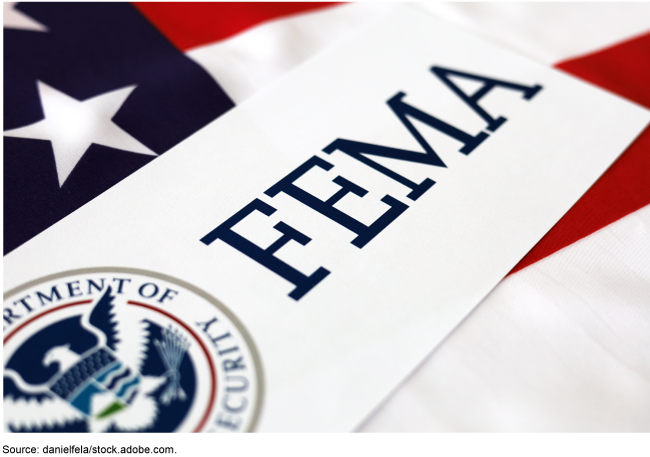FEMA: Opportunities Exist to Address Mission Challenges and Increased Workload
Fast Facts
The Federal Emergency Management Agency leads our nation's effort to prepare for, respond to, and recover from disasters.
In recent years, FEMA has been called on to help in even more emergencies—stretching its workforce and resources. In this testimony, we discuss our prior work on FEMA's response to challenges such as COVID-19 and sheltering at the southern border.
We also discuss FEMA's longstanding challenges related to staffing shortages, workplace morale, staff development, and workforce qualifications.
We continue to monitor FEMA's progress at addressing our prior recommendations on these issues.

Highlights
What GAO Found
The increasing frequency of disasters overall and the additional responsibilities for responding to other events have stretched the Federal Emergency Management Agency's (FEMA) workforce in unprecedented ways. GAO's work has identified various challenges FEMA has faced in its efforts to respond to these additional events.
The scale and scope of federal efforts and funding required to address the COVID-19 pandemic tested FEMA's and other federal agencies' capacity to mount an equitable and effective nationwide response. FEMA's role included lost wages assistance; COVID-19 funeral assistance; public assistance to state, tribal, and territorial governments; mission assignments to other federal agencies; and mobile vaccination units. For example, GAO reported in April 2022 that FEMA had received and was processing more than 444,000 applications for COVID-19 funeral assistance since April 2021—when it began accepting applications—compared to the approximately 6,000 cases of funeral assistance the agency had processed over the decade prior to the pandemic. FEMA reported that as of December 2023 it has obligated $123 billion in response to the pandemic and projected that it will obligate a total of $144 billion by the end of fiscal year 2024. In addition to the 59 major disaster declarations for COVID-19, as of July 2022, FEMA had about 500 non-COVID-19 active major disaster declarations in various states of response and recovery. At the same time, FEMA recently reported a projected deficit of nearly $6.4 billion in the fund by September 2024
GAO has also identified several gaps in FEMA's internal controls meant to prevent improper or potentially fraudulent payments in funeral assistance. In April 2022, GAO recommended that FEMA implement additional control activities to ensure that consistent and accurate data are available to prevent and detect improper payments and potential fraud. FEMA has fully addressed this recommendation implementing additional controls but as of April 2023 has only partially addressed the recommendation on data consistency and accuracy. Until FEMA fully addresses this recommendation, they will continue limited ability oversee and prevent and detect fraud.
GAO's past work has identified longstanding challenges facing the FEMA workforce, which have been exacerbated given FEMA's additional responsibilities. Specifically, in May 2023, GAO reported that FEMA had a disaster workforce strength of approximately 11,400 employees at the beginning of fiscal year 2022, a gap of 35 percent between the actual number of staff and the staffing target of 17,670. FEMA officials stated that they faced additional responsibilities due to COVID-19, while also managing the traditional seasonal peaks of disaster activity during the year. This created burnout for many employees and increased employee attrition. GAO recommended that FEMA document plans to monitor and evaluate the agency's hiring efforts to address staffing gaps, among other recommendations. As of January 2024, FEMA has taken some steps to address these recommendations, including developing yearly hiring targets to ensure they are on pace to meet overall hiring goals. To fully address the recommendation, FEMA should finalize its staffing plans.
Why GAO Did This Study
FEMA leads the nation's efforts to prepare for, respond to, and recover from disasters. In recent years, the increasing frequency and costs of disasters, the COVID-19 pandemic, and other responsibilities have placed additional pressures on FEMA.
This statement discusses GAO's prior work and recommendations related to FEMA's (1) roles and responsibilities outside of natural disasters and (2) workforce challenges.
This statement is based on products GAO issued from May 2020 through May 2023, along with selected updates to address GAO recommendations, and updates from FEMA. For those products, GAO reviewed and analyzed federal laws, agency guidance, and other agency documents. GAO also analyzed data on FEMA's workforce, and disaster assistance, among others. GAO interviewed knowledgeable officials from FEMA; other selected federal agencies; and state, local, and territorial officials impacted by disasters.
Recommendations
GAO has made 24 recommendations in prior reports designed to address the various mission and management challenges discussed in this statement. FEMA has taken steps to address these recommendations. GAO will continue to monitor FEMA's efforts to determine if they fully address the challenges GAO has identified.
